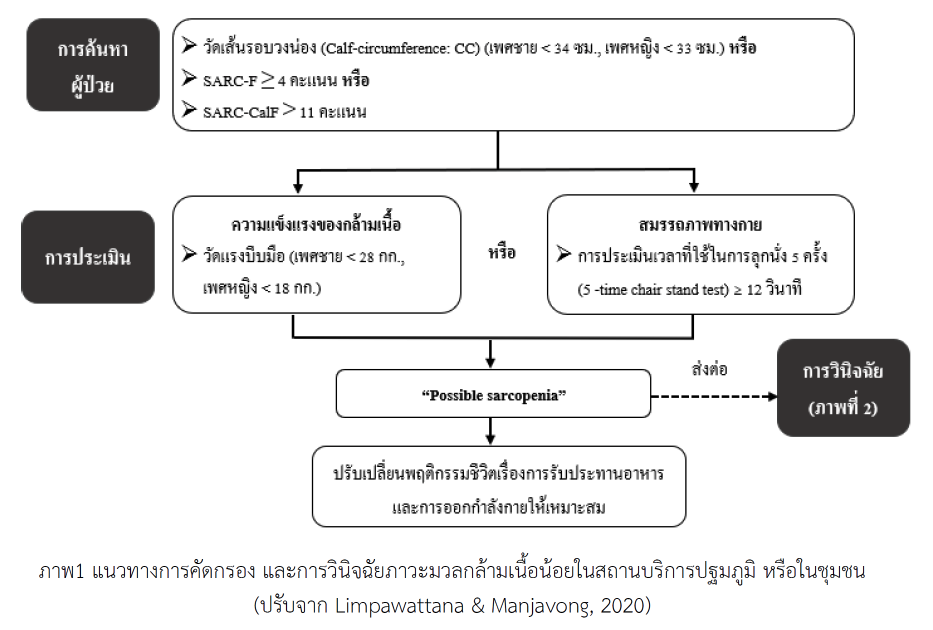HEALTH PROMOTION AND PREVENTION FOR SARCOPENIA IN OLDER ADULTS
Keywords:
health promotion and prevention, sarcopenia, older adultsAbstract
Sarcopenia, a geriatric syndrome, becomes more prevalent with advanced age. Typically, it results from progressive muscle mass loss and decreased muscle strength and/or physical function, leading to functional decline and an increased risk of falls and fractures, requiring hospitalization. If early sarcopenia screening is not appropriately administered, the profound impacts of delayed prevention and treatment can result in adverse health outcomes, increased dependency, and a diminished quality of life for older adults. Given the essential role that nurses play in providing healthcare to older adults, understanding the concept of sarcopenia is crucial. This article aims to propose guidelines for managing sarcopenia in older adults, emphasizing the importance of early screening for sarcopenia in hospitals and community settings. The ultimate goal is to raise awareness, prevent sarcopenia, and mitigate its progression or severity, enabling older adults to maintain their independence.
Downloads
References
Akarapornkrailert P., Muangpaisan W., Boonpeng A., & Daengdee D. (2020). Validation of the Thai version of SARC-F, MSRA-7, and MSRA-5 questionnaires compared to AWGS 2019 and sarcopenia risks in older patients at a medical outpatient clinic. Osteoporos Sarcopenia, 6(4), 205-211. http://doi.org/10.1016/j.afos.2020.11.006
Atherton, P. J., Greenhaff, P. L., Phillips, S. M., Bodine, S. C., Adams, C. M., & Lang, C. H. (2016). Control of skeletal muscle atrophy in response to disuse: Clinical/preclinical contentions and fallacies of evidence. American journal of physiology. Endocrinology and metabolism, 311(3), E594–E604. http://doi.org/10.1152/ajpendo.00257.2016
Barbosa-Silva, T. G., Menezes, A. M., Bielemann, R. M., Malmstrom, T. K., Gonzalez, M. C., & Grupo de Estudos em Composição Corporal e Nutrição (COCONUT). (2016). Enhancing SARC-F: Improving sarcopenia screening in the clinical practice. Journal of the American Medical Directors Association, 17(12), 1136–1141. http://doi.org/10.1016/j.jamda.2016.08.004
Baumgartner, R. N., Koehler, K. M., Gallagher, D., Romero, L., Heymsfield, S. B., Ross, R. R., . . . Lindeman, R. D. (1998). Epidemiology of sarcopenia among the elderly in New Mexico. American Journal of Epidemiology, 147(8), 755-763. http://doi.org/10.1093/oxfordjournals.aje.a009520
Chen, L. K., Arai, H., Assantachai, P., Akishita, M., Chew, S. T. H., Dumlao, L. C., . . . Woo, J. (2022). Roles of nutrition in muscle health of community-dwelling older adults: Evidence-based expert consensus from Asian Working Group for Sarcopenia. Journal of Cachexia, Sarcopenia and Muscle, 13(3), 1653-1672. http://doi.org/10.1002/jcsm.12981
Chen, L. K., Woo, J., Assantachai, P., Auyeung, T. W., Chou, M. Y., Iijima, K., . . . Arai, H. (2020). Asian working group for sarcopenia: 2019 consensus update on sarcopenia diagnosis and treatment. Journal of the American Medical Directors Association, 21(3), 300-307. http://doi.org/10.1016/j.jamda.2019.12.012
Cruz-Jentoft, A. J., Baeyens J. P., Bauer J.M., Boirie, Y., Cederholm, T., Landi, F., . . . Zamboni, M. (2010). Sarcopenia: European consensus on definition and diagnosis: Report of the European working group on sarcopenia in older people. Age Ageing, 39(4), 412-423. http://doi.org/10.1093/ageing/afq034
Cruz-Jentoft, A. J., Bahat, G., Bauer, J., Boirie, Y., Bruyère, O., Cederholm, T., . . . The Extended Group for EWGSOP2. (2019). Sarcopenia: Revised European consensus on definition and diagnosis. Age and Ageing, 48(1), 16–31. http://doi.org/10.1093/ageing/afy169
Gao, Q., Mei, F., Shang, Y., Hu, K., Chen, F., Zhao, L., & Ma, B. (2021). Global prevalence of sarcopenic obesity in older adults: A systematic review and meta-analysis. Clinical Nutrition (Edinburgh, Scotland), 40(7), 4633-4641. http://doi.org/10.1016/j.clnu.2021.06.009
Huang, L. T., & Wang, J. H. (2021). The therapeutic intervention of sex steroid hormones for sarcopenia. Frontiers in Medicine, 8, 739251. http://doi.org/10.3389/fmed.2021.739251
Khongsri N., Tongsuntud S., Limampai P., & Kuptniratsaikul V. (2016). The prevalence of sarcopenia and related factors in a community-dwelling elders Thai population. Osteoporos Sarcopenia, 2(2), 110-115. http://doi.org/10.1016/j.afos.2016.05.001
Kitamura, A., Seino, S., Abe, T., Nofuji, Y., Yokoyama, Y., Amano, H., . . . Shinkai, S. (2021). Sarcopenia: Prevalence, associated factors, and the risk of mortality and disability in Japanese older adults. Journal of Cachexia, Sarcopenia and Muscle, 12(1), 30-38. http://doi.org/10.1002/jcsm.12651
Lim, W. S., Chew, J., Lim, J. P., Tay, L., Hafizah, N., & Ding, Y. Y. (2019). Letter to the editor: Case for validated instead of standard cut-offs for SARC-CalF. The Journal of Nutrition, Health & Aging, 23(4), 393–395. http://doi.org/10.1007/s12603-019-1177-y
Lin, Z., Zhao, A., & He, J. (2022). Effect of β-hydroxy-β-methylbutyrate (HMB) on the muscle strength in the elderly population: A meta-analysis. Frontiers in Nutrition, 9, 914866. http://doi.org/10.3389/fnut.2022.914866
Limpawattana, P. (2018). Frailty and sarcopenia. In P. Limpawattana (Eds.), Geriatric syndromes and interesting health issues (pp.203-221) (2nd ed.). Khon Kaen: Klungnana Vitthaya.
Limpawattana, P., & Manjavong, M. (2020). Clinical practice for sarcopenia. KKU Journal of Medicine, 6, 7-16.
Malmstrom, T. K., & Morley, J. E. (2013). SARC-F: A simple questionnaire to rapidly diagnose sarcopenia. Journal of the American Medical Directors Association, 14(8), 531-532. http://doi.org/10.1016/j.jamda.2013.05.018
Morley, J. E. (2016). Pharmacologic options for the treatment of sarcopenia. Calcified Tissue International, 98(4), 319-33. http://doi.org/10.1007/s00223-015-0022-5
Moro, T., Brightwell, C. R., Volpi, E., Rasmussen, B. B., & Fry, C. S. (2020). Resistance exercise training promotes fiber type-specific myonuclear adaptations in older adults. Journal of Applied Physiology, 128(4), 795–804. http://doi.org/10.1152/japplphysiol.00723.2019
Panasupon, L. (2016). Effect of progressive resistance and aerobic exercise training on physical performance in elderly women with sarcopenia (Master of science program, sports medicine). Faculty of Medicine, Chulalongkorn University, Bangkok, Pathumwan.
Petermann-Rocha, F., Balntzi, V., Gray, S. R., Lara, J., Ho, F. K., Pell, J. P., & Celis-Morales, C. (2022). Global prevalence of sarcopenia and severe sarcopenia: A systematic review and meta-analysis. Journal of Cachexia, Sarcopenia and Muscle, 13(1), 86-99. http://doi.org/10.1002/jcsm.12783
Pongchaiyakul, C., Limpawattana, P., Kotruchin, P., & Rajatanavin, R. (2013). Prevalence of sarcopenia and associated factors among Thai population. Journal of Bone and Mineral Metabolism, 31(3), 346-350. http://doi.org/10.1007/s00774-013-0422-4
Robinson, S. M., Reginster, J. Y., Rizzoli, R., Shaw, S. C., Kanis, J. A., Bautmans, I., . . . ESCEO working group. (2018). Does nutrition play a role in the prevention and management of sarcopenia? Clinical Nutrition (Edinburgh, Scotland), 37(4), 1121–1132. http://doi.org/10.1016/j.clnu.2017.08.016
Rom, O., Kaisari, S., Aizenbud, D., & Reznick, A. Z. (2012). Lifestyle and sarcopenia-etiology, prevention, and treatment. Rambam Maimonides Medical Journal, 3(4), e0024. http://doi.org/10.5041/rmmj.10091
Rosenberg, I. H. (1997). Sarcopenia: Origins and clinical relevance. The Journal of Nutrition, 127(5 Suppl), 990s-991s. http://doi.org/10.1093/jn/127.5.990S
Therakomen, V., Petchlorlian, A., & Lakananurak, N. (2020). Prevalence and risk factors of primary sarcopenia in community-dwelling outpatient elderly: A cross-sectional study. Scientific Reports, 10(1), 19551. http://doi.org/10.1038/s41598-020-75250-y
Vikberg, S., Sörlén, N., Brandén, L., Johansson, J., Nordström, A., Hult, A., & Nordström, P. (2019). Effects of resistance training on functional strength and muscle mass in 70-year-old individuals with pre-sarcopenia: A randomized controlled trial. Journal of The American Medical Directors Association, 20(1), 28–34. http://doi.org/10.1016/j.jamda.2018.09.011
Volkert, D., Beck, A. M., Cederholm, T., Cruz-Jentoft, A., Hooper, L., Kiesswetter, E., . . . Bischoff, S. C. (2022). ESPEN practical guideline: Clinical nutrition and hydration in geriatrics. Clinical nutrition (Edinburgh, Scotland), 41(4), 958–989. http://doi.org/10.1016/j.clnu.2022.01.024
Yeung, S. S. Y., Reijnierse, E. M., Pham, V. K., Trappenburg, M. C., Lim, W. K., Meskers, C. G. M., & Maier, A. B. (2019). Sarcopenia and its association with falls and fractures in older adults: A systematic review and meta-analysis. Journal of Cachexia, Sarcopenia and Muscle, 10(3), 485–500. http://doi.org/10.1002/jcsm.12411

Downloads
Published
How to Cite
Issue
Section
License
Copyright (c) 2023 JOURNAL OF THE POLICE NURSES

This work is licensed under a Creative Commons Attribution-NonCommercial-NoDerivatives 4.0 International License.
ผลงานที่ได้ตีพิมพ์แล้วจะเป็นลิขสิทธิ์ของวารสารพยาบาลตำรวจ














